Tuxcacuesco
Hacienda de Apulco
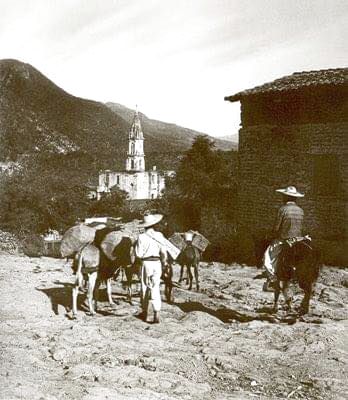
Apulco
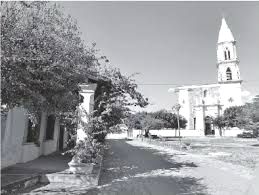
Carlos Vizcaino’ Basilica de Nuestra Señora del Refugio, Apulco
The Hacienda of Apulco, in the municipio of Tuxcacuesco, on its border with Tonaya and San Gabriel, was constructed by Carlos Vizcaíno in 1884.
In May 1915 Carlos Vizcaíno and his son, Vicente, issued notes in three values. These notes were legalised by the Agente de Timbre in San Gabriel and so have a certification on the reverse, referring to article 246 of the general legalisation on stamp duty (Ley de la Renta Federal del timbre) of 1 June 1906, which makes provision in the event of a lack of revenue stampsArt. 246. Si en algún lugar faltaren estampillas, el que necesite timbrar un documento ó libro lo presentará á la oficina del Timbre para que lo legalice, previo el pago del impuesto de las estampillas que debieran usarse, y poniendo una nota de legalización que autorizará el jefe de la oficina, quien expedirá al interesado una certificación de haber hecho el pago en efectivo por falta de estampillas and states that the holders of documents should present them to the oficina del Timbre and the jefe will certify that the holder has paid cash in place of the required stamps.
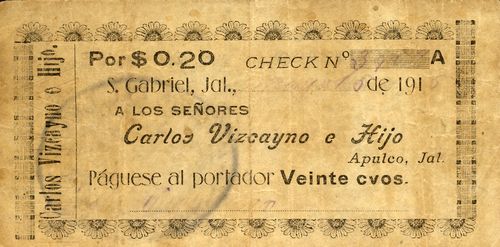
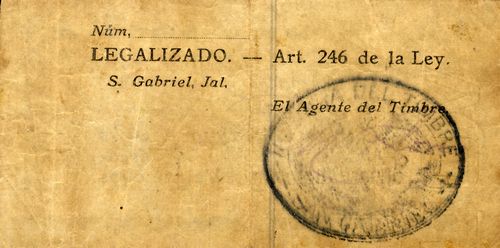 M2599 20c Hacienda de Apulco
M2599 20c Hacienda de Apulco
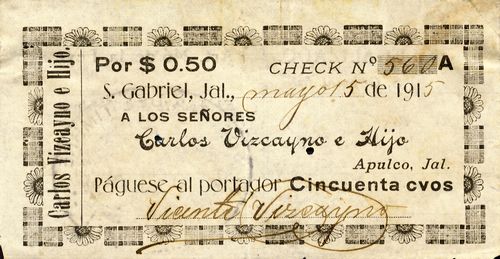
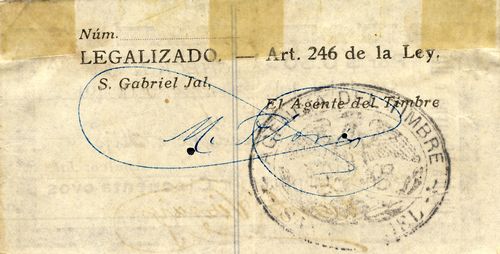 M2600 50c Hacienda de Apulco
M2600 50c Hacienda de Apulco

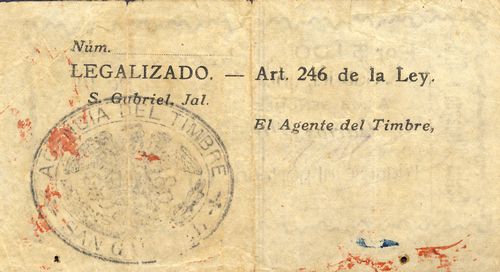 M2601 $1 Hacienda de Apulco
M2601 $1 Hacienda de Apulco
| date on note | series | from | to | total number |
total value |
||
| 20c | 15 May 1915 | A | includes numbers 2156 to 39[ ] | ||||
| 50c | 15 May 1915 | A | includes number 560 | ||||
| $1 | 15 May 1915 | A | includes number 67 |
|
In 1885 he bought the "Rancho Apulco", located on the land of the hacienda of La Guadalupe, in San Gabriel, owned by Guadalupe Morett. He also bought in 1888 from María Carmen Sofía Morett Villa the lands of "El Rincón de la Piña" and "Higuera Blanca" with the plots of "Los Noxtles" for the sum of $4,900. On the death of his father Carlos received an inheritance consisting of several rustic plots of land and a lot of livestock. His brothers sold him what they were entitled to from their father's legacy. Carlos married Tiburcia Arias Vargas (daughter of Juan Arias and Feliciana Vargas Cuevas) on 16 May 1874. They had as children José María, Enrique, Miguel, Francisco, Ramón, who died very young, Ygnacia, Vicente and MaríaMaría Vizcaíno y Arias married Juan Nepomuceno Pérez Rulfo in the chapel of the hacienda on 31January 1914 and on 16 May 1917 gave birth to Juan Nepomuceno Carlos Pérez Rulfo Vizcaíno, best known as Juan Rulfo. Juan Rulfo was a Mexican writer, screenwriter, and photographer, best known for two literary works, the 1955 novel Pedro Páramo, and the collection of short stories El Llano en llamas. This collection includes the popular tale "¡Diles que no me maten!". In 1892 he began the construction of the church in Apulco, a task that took until 1910, but “Carlos had made the commitment before God; he was a man of the nineteenth century, although with a medieval ideology. More than being interested in his earthly riches and goods, he was concerned with the salvation of his soul.” A few months later the Mexican Revolution began. In March 1914 Carlos was kidnapped by Villistas under Pedro Zamora. Carlos had to leave Apulco and took refuge in San Gabriel with his family, temporarily establishing his home in calle Zaragoza, (today calle Hidalgo). Carlos Vizcaíno died in San Gabriel on 17 September 1920José de Jesús Guzmán Mora, Personajes que han forjado la historia de San Gabriel, tomo IV, 2021. Guzmán Mora is the municipal chronicler of San Gabriel. |
|
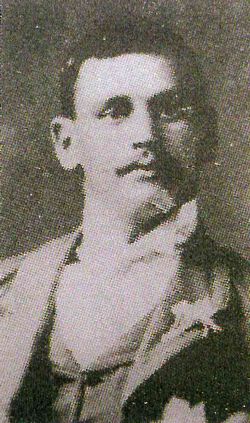 Vicente Vizcaíno was born at Salvatierra, Guanajuato, on 4 April 1881. Vicente Vizcaíno was born at Salvatierra, Guanajuato, on 4 April 1881. |
 |
Tuxpan
Hacienda del Valle Florido
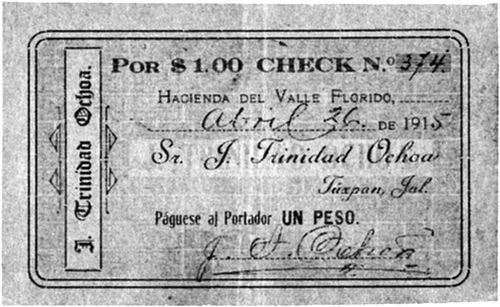 M2753 $1 Hacienda de Valle Florido
M2753 $1 Hacienda de Valle Florido
| date on note | to | from | total number |
total value |
||
| $1 | 26 April 1915 | includes number 374 |
This was printed in red and green on cream paper, with a handwritten date and signature.
|
José Trinidad Ochoa Alatorre was born in Zacoalco de Torres, Jalisco, on 19 November 1862. On 10 July 1923 his firm provided the first electric service to Tuxpan. He died in Tuxpan on 23 November 1933. |
 |
Unión de Tula
Hacienda San Clemente
At the end of the 19th century San Clemente was in the hands of the Palomar y Corcuera family. Concepción Loyzaga y Corcuera de Palomar, niece of Manuel Luna and married to Agustín Palomar García Sancho, was owner of the estate.
These cartones were modelo 5162, produced by Juan Kaiser on 16 June 1916 and valid until 1 October 1916..
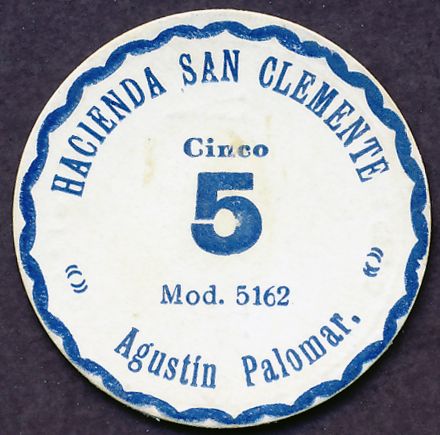
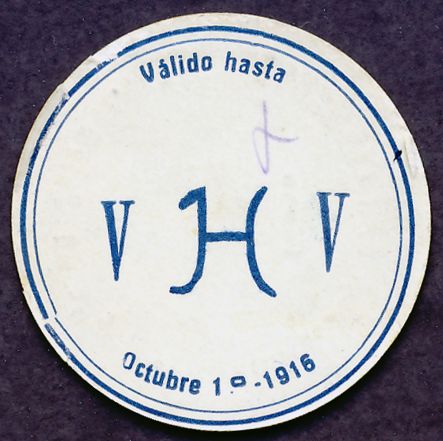 M2590 5c Hacienda San Clemente
M2590 5c Hacienda San Clemente
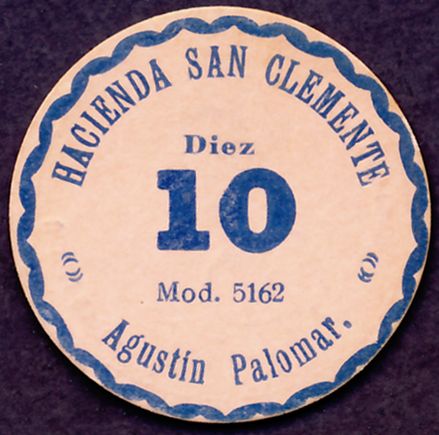
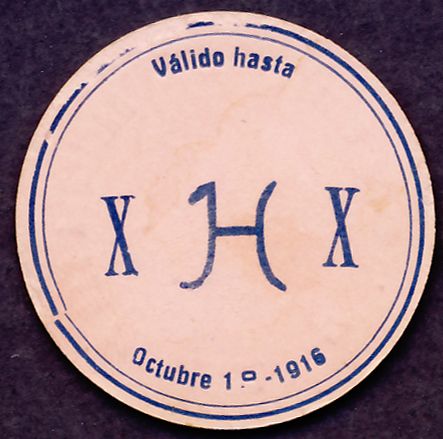 M2591 10c Hacienda San Clemente
M2591 10c Hacienda San Clemente
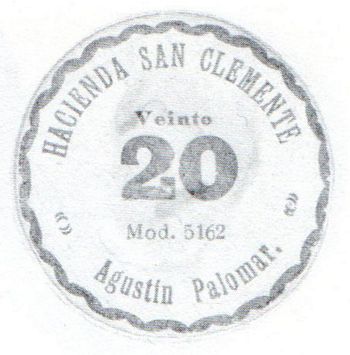 M2592 20c Hacienda San Clemente
M2592 20c Hacienda San Clemente
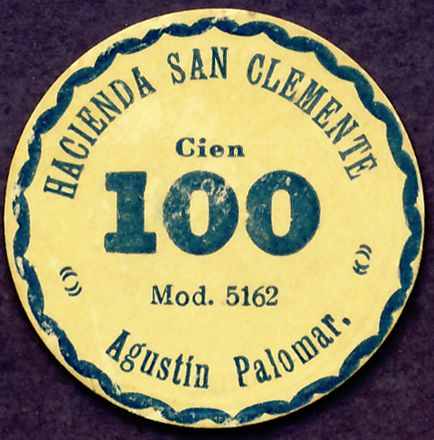
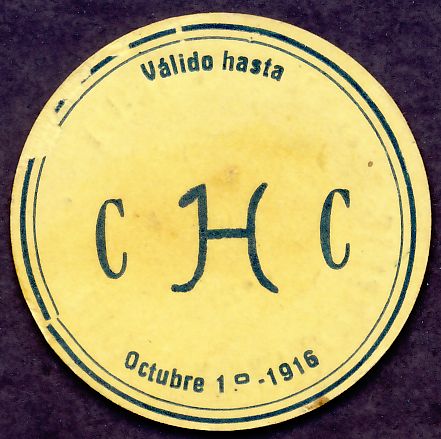 M2594 $1 Hacienda San Clemente
M2594 $1 Hacienda San Clemente
| total number |
total value |
||
| 5c | 1,000 | $ 50.00 | round blue cartón |
| 10c | 1,000 | 100.00 | round pink cartón |
| 20c | 1,000 | 200.00 | round green cartón |
| 50c | 500 | 250.00 | round orange cartón |
| $1 | 500 | 500.00 | round yellow cartón |
| 4,000 | $1,100.00 |
Hacienda Santa Rosa
This $1 note carries the name of José Santa María.
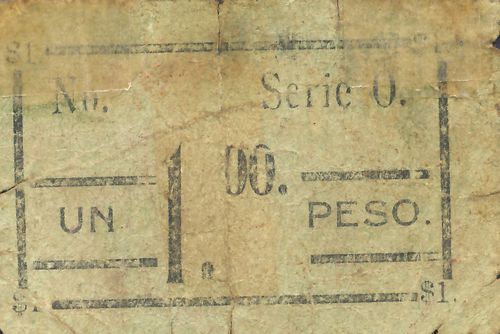
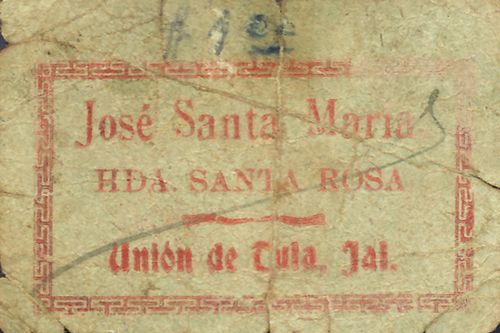 M2758 $1 Hacienda Santa Rosa
M2758 $1 Hacienda Santa Rosa
| series | from | to | total number |
total value |
||
| $1 | O | includes number [81] |
Zapoltiltic
Zapotiltic is a town just 15 kilometres south-east of Ciudad Guzmán.
Hacienda El Rincón
The hacienda El Rincón was founded in 1895 by Severo Gómez Vizcaíno and Carlota Gómez Adame. It was a little over 7,000 hectares and employed more than 200 workers in producing sugar cane. The hacienda was drastically reduced after the revolution and now has only 120 hectares.
In 1915 the widow Carlota Gómez issued cheques signed by her Administrador, Adrián Cordero. These were endorsed on the back to certify that the 2c due in stamp duty had been paid, even though revenue stamps were unavailble (Legalizado y recaudado en efectivo $0.02 dos centavos por no haber estampillas Arts. 246 y 247 de la Ley Timbre vigente. Ciudad Guzmán, Julio 7 de 1915. ADMOR. SUBALTERNO).
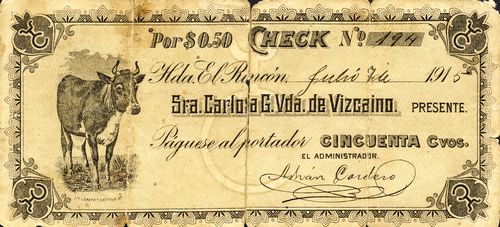
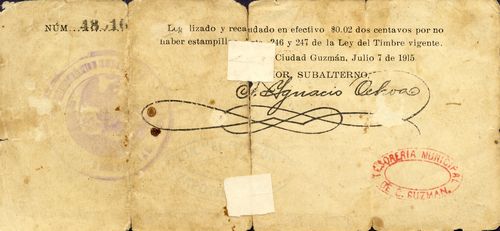 M2779 50c Hacienda El Rincón
M2779 50c Hacienda El Rincón
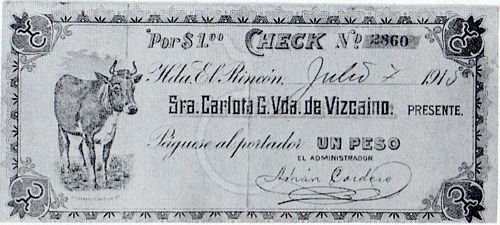 M2780 $1 Hacienda El Rincón
M2780 $1 Hacienda El Rincón
| date on note | from | to | total number |
total value |
||
| 50c | 7 July 1915 | includes number 194 | ||||
| $1 | 7 July 1915 | includes number 2860 |
| Adrián Cordero |  |
Strangely, although these are identical to the Hacienda El Limón cheques they were printed by the Litográfia Loreto y Castillo of Guadalajara, rather than the Litográfia Industrial.

 José Carlos Vizcaíno Vargas was born in La Piña, in the municipality of Tonaya, on 2 October 1846. He became the owner of La Piña, where he distinguished himself as a man of great industriousness and progress, and in a short time increased his wealth.
José Carlos Vizcaíno Vargas was born in La Piña, in the municipality of Tonaya, on 2 October 1846. He became the owner of La Piña, where he distinguished himself as a man of great industriousness and progress, and in a short time increased his wealth.